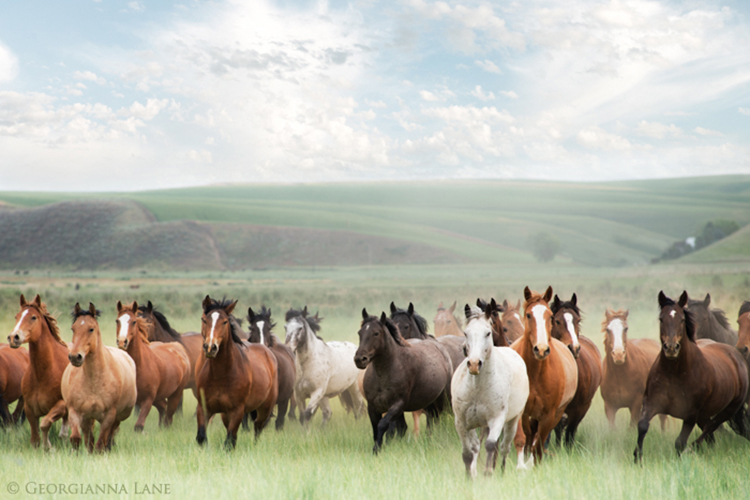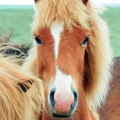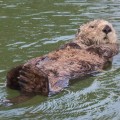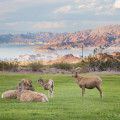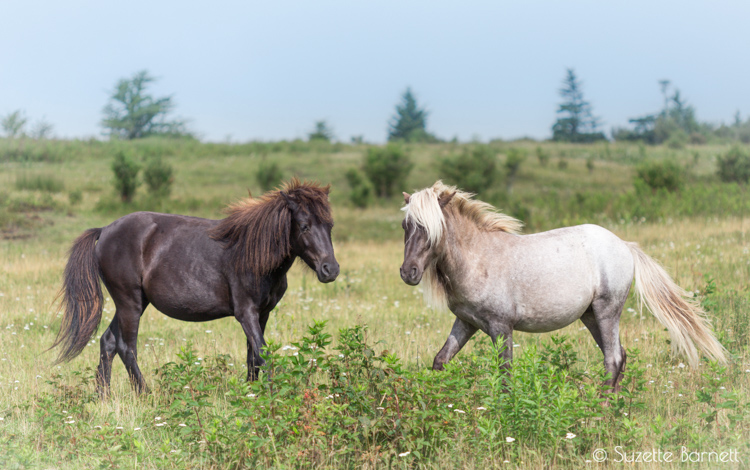
Majestic wild ponies photographed one morning at Grayson Highlands State Park in Virginia.
Out of personal interest, I’ve done quite a bit of research into where to find wild horses and ponies. From Wyoming to Iceland and beyond, I highly recommend an adventure to see these beautiful animals in their natural habitat. It is entirely possible that I am the only person in the world interested in something like this, but here it is for animal lovers and wildlife photographers who may appreciate all the information in one easily digestible place.
Wild Ponies: Where Are They?
Grayson Highlands State Park, Virginia: This park which spans 4,500 acres is popular for it’s hiking trails including one leg of the Appalachian Trail. With peaks reaching elevations of 5,000 feet the highlands offer scenic vistas, extreme weather, and wild highland ponies. These 100-or-so ponies roam freely within the boundaries of the park finding their own food, water and shelter. Aside from a yearly round up and auction, they are left alone. To me, these ponies are extra beautiful because they have heavy coats and manes and who doesn’t love a fluffy pony? If you’re lucky you might see Fabio, a pony whose mane reaches to the ground. Access is very simple, just park at Massie Gap and head onto the main trail.
Assateague Island National Seashore, Virgina: This island encompasses 37 miles of beach and is home to inland forests, salt marshes and an estimated 300 wild ponies. Tours are available for pony-watching, cruises and kayaking excursions. Bird species are abundant too, with endless opportunities to see falcons, egrets, sandpipers, osprey, gulls and more.
Chincoteague Island, Virgina: For one full week each July a major pony event here draws tens of thousands of visitors. Approximately 150 adult ponies and 60 or so foals are herded up by cowboys and brought from Assateague Island to Chincoteague Island for auction. The ponies continue to procreate and the island can only facilitate some 300 ponies. Several companies offer tours throughout that week to catch a glimpse of them. A great photo opportunity is “The Beach Walk” when cowboys bring the ponies across a stretch of beach relocating them to another corral. The most beloved festivity though is the “Pony Swim”, something you’d have to see to believe. Some people claim their waterfront viewing spots two days in advance or they buy tickets for a boat tour and they cheer-on the ponies swimming across the channel. Afterwards, the winning pony is given away in a raffle and all the ponies are paraded down Main Street before the auction. I mean, is this for real?
Red Rock Canyon National Conservation Area, Nevada: Located just 20 miles from Las Vegas is a 220,000 acre piece of the Mojave Desert with 16-27 free roaming horses and 29-49 wild burros. I know these aren’t ponies, but come on, they’re donkeys. Close enough. The donkeys often congregate near Bonnie Springs, Spring Mountain Ranch and the town of Blue Diamond along State Route 159. If you’re looking for the horses, head to the northern end of Red Rock near Cold Creek or the southern end of Red Rock on the dirt road leading from State Route 160 to Goodsprings. Other nearby herds are located at Muddy Mountain (50 burros), Johnnie Herd (50 horses, 50 burros), and Gold Butte Herd (numbers unknown). Do a little rain dance because this landscape and weather is harsh and numbers are on the decline during this drought.
Dülmen, Germany: Over 300 adult ponies roam here on a 865-acre nature preserve among numerous hiking trails, woods and meadows. Located in an area known as Merfelder Bruch in west Germany, the Dülmen Pony breed dates back to the year 1316 and is the only native wild pony in the country. With powdery coats of light grays and browns, these ponies are particularly picturesque. For the safety and conservation of the herd(s) there is an annual roundup and auction on the last Saturday of May. Visitors often couple this visit with a stop at the Royal Andalusian School of Equestrian Art to see the famous baroque horses. It’s here you’ll also see Knabstruppers, a gorgeous royal horse breed with spotted coats.
Sable Island, Nova Scotia, Canada: Home to a unique breed called the Sable Pony, this small island is essentially a narrow, crescent shaped sandbar. Located just southeast of Halifax, it draws nature lovers to it’s wildlife, sand dunes, meadows, freshwater ponds, shipwrecks and often foggy coastline. Interestingly, there are no trees–only grasses, shrubs and flowers. Protected by the Parks Department of Canada (it became a National Park Reserve in 2013) the island is a base for a small team of researchers who must grant permission to anyone who wants to visit. The wild ponies number over 550, most being 50-57 inches tall, often with a thick mane to protect them from cold winds and storms.
Where to Find Wild Horses (not ponies)
Not many things are more iconic in the old west than horses roaming the prairie or their powerful galloping with manes flying in the air. Wyoming and Nevada are home to the country’s largest wild horse populations. Bring binoculars. Wyoming’s wild horses have been said to number over 6,000 but the Bureau of Land Management is working to keep the numbers to a sustainable 3,100 so they put the excess up for adoption each year. Spring is always a nice time to visit when you have a greater chance of seeing foals come out to play.
DeerWood Ranch Wild Horse EcoSanctuary, Laramie, Wyoming: This is the very first Wild Horse Eco Sanctuary on private land in the US. Their property has a river running through it, abundant cotton and willow trees, and covers 4,700 acres that is home to 300 wild mustangs. Other wildlife you’ll see here includes native deer, elk and coyotes. Visits couldn’t be easier because they operate a year-round guest cabin right on the property.
Pryor Mountain Herd, Wyoming and Montana: Derived from Portugal and Spain, this herd of 120-160 wild mustangs is probably the most famous in our country and has lived in this rugged mountain area for over 200 years. They roam a massive 38,000 acres of land straddling the Wyoming / Montana border, not too far from Yellowstone. A non-profit organization known as the Pryor Mountain Wild Mustang Center works to protect them and educate people about the herd’s special role in Colonial American history. Lucky for us, they also offer viewing tours to the public. If you want to find mustangs on your own, first consult the Mustang Center for latest news on where the horses have been spotted. They are usually seen along Highway 37 when heading toward the Bighorn Canyon National Recreation Area via Devil’s Canyon Overlook and Bad Pass Road.
Wind River Wild Horse Sanctuary, Lander, Wyoming: This sanctuary is located on a Native American reservation. Opened in partnership with the Bureau of Land Management, they oversee 130 mustangs. They are open all summer long, or in the winter by appointment only. Check out their visitor center and join a guided tour of the property.
Theodore Roosevelt National Park, North Dakota: This 70,000-acre park attracts visitors with camping sites along the Little Missouri River, walking and hiking and horseback riding trails. Backcountry camping and hiking are also allowed with permits. Still, the most popular reason people come here is to view the wildlife: horses, bison, elk, longhorn steer, bighorn sheep, deer, gold eagles, and 186 species of birds. Early summer is the best time to visit with the landscape turning green and covered with wildflowers. This location also has excellent star visibility at night and occasional display of the northern lights! During the summer, bands of horses can be seen grazing on the green plateaus in the southeast section of the park and along the park’s border from Interstate Highway 94. Herds can also be spotted from the Painted Canyon Overlook or the top of Buck Hill.
Challis, Idaho: The Wild Love Preserve is a non-profit organization that seeks to protect Idaho’s native wild horse population, which now numbers around 130. You may be pleased to know that they partner with a tour company to offer you maximum wild horse and scenic viewing opportunities.
Black Hills Horse Sanctuary, South Dakota: This idyllic sanctuary spans 11,000 acres where more than 600 mustangs run free, many of which were rescued from an unpleasant fate. The sanctuary relies entirely on public donations to offer the best life of freedom for these horses; rent one of their cabins and take their viewing tour so that you, too, can enjoy the view.
Pilot Butte Scenic Loop, Wyoming: This destination can be visited on a 50-mile drive on gravel roads, which can start either in Green River or Rock Springs. You’ll get a chance for some great panoramas of the Wyoming Range to the west, the Wind River Range to the northeast and the Uinta Range to the south. Wildlife includes horses (numbering over 800), antelope, grouse, coyotes, rabbits, hawks and eagles. Allow half a day at least for the visit, bring food and water and a full tank of gas. A high-clearance vehicle is recommended, or you make your life easy by joining a horse-viewing tour. They actually suggest you contacts the Bureau of Land Management before you visit because they may have wild horse roundups or auctions so you could see some of the the horses in one place.
McCullough Peaks, Wyoming: Near Cody is a Wild Horse Management Area encompassing 109,000 acres of desert land and 100-150 wild horses noted for their beautifully colored coats. Again, a high clearance vehicle is recommended due to the rugged terrain and extreme caution is necessary in or after rains. Because of this and their expertise in finding the best views of the wild mustangs, a Wild Mustang Tour brings visitors in from Cody and people rave about it. Often times the horses can be seen right from the Interstate Highway 14-16-20, so this might be an option if you are short on time or not driving a truck. It’s worthy of note for photographers that stormy weather has been known to make the wild horses restless and even cause fighting among the stallions. The nearby Red Canyon River is particularly picturesque and home to white water rafting, kayaking, canoeing, and paddle boarding. This was also the primary filming location for Disney’s film “Meet the Deedles”.
Cumberland Island, Georgia: Located 345 miles southeast of Atlanta is this island off the coast of Georgia which spans 17 miles of forests, dunes, marshes and windswept beaches. It is home to over 9,800 acres of wilderness and 120-200 wild horses.
Shannon County, Missouri: Running free for over 100 years, there are currently four or five herds here, some of them almost entirely white horses. They can be seen in the areas surrounding the two rivers of Shannon County; Current River and Jack’s Fork River. I heard that the best viewing spots are the Broadfoot fields north of Eminence, the Shawnee fields east of Eminence, and the fields above Two Rivers on Highway 5.
Cowboy Trail, Alberta Canada: Primarily in the foothills near the Alberta Highway 22 (not far from Banff National Park) you might see wild horses at the side of the road, on ridges or crossing rivers. Referred to as “wildies” these horses are a mix of domesticated and work horses that were at some point set free.
Doubs Park, Switzerland: Roaming free all summer long on extensive highland pastures are some 5000 Freiberger horses, the only horse breed of Swiss origin. It couldn’t be any easier to find them because each day their locations are kindly mapped online for use by visitors.
Camargue, south France: Perhaps one of the most photographed horses in the world, the ancient breed of Camargue horse is indigenous to this area of southern France. For centuries they have survived here in the wild and have become a popular sight at the Camargue marshes and wetlands. This breed always has a white hair coat. The horses today are bred, used to manage livestock, trained for equestrian shows. From May to September there are guided tours of the Camargue horses in their natural habitat, and also often independent photography tours you can find in a quick online search.
New Forest, England: The smallest National Park in Great Britain, the New Forest Nature Reserve was founded in 1079 and today is visited by holiday-goers who want to enjoy the almost 3000 wild ponies who live here. With a habitat of 186 square miles of pastures and forest, their habitat is limited by the borders of the Nature Reserve. You can explore the park by foot, bicycle, guided tour bus, kayak or even horseback!
Icelandic Horses, Iceland: When visiting this neck of the world you’ll see little Icelandic horses without even trying. But if you’re serious about getting a unique view of them in action, Icelandic horse races are held throughout the country from April through June. Winter events are also often held showcasing the small horses, including races on frozen water. While it’s regular to see the roaming horses throughout the Ring Road by just driving and pulling off to the side of the road when they appear, my friend Meg Jerrard of Mapping Megan says the most notable viewing spot is on the Snæfellsnes Peninsula.
Easter Island: Some joke that this destination’s slogan should be “Come for the statues, stay for the horses.” Horse population estimates range from 3,000 to 6,000, a number which if accurate, means there are more horses here than humans. Though the horses do roam free, they are all owned by someone and often branded. Many choose to admire and photograph them from horseback or hiking trails.
Altai, Mongolia: This horse is an ancient breed of the region, taking their name from the Altai mountains of Mongolia. Once having roamed all over Europe and Asia, different breeds eventually were introduced for purposes of larger animals and maximum work potential. Some of the mountain scenery makes for excellent photographs of the wild horses.
Galicia, Spain: This northern Spain region is well known for it’s 400-year-old “Capture of the Beasts” festival in the town of Sabucedo where they round up hundreds of wild horses from the mountains to trim their tails and manes, offer vaccinations and microchips. The ritual is fairly aggressive from the images I have seen, though it draws thousands of tourists each year. The horses typically belong to ranchers who let their horses roam free in the mountains which helps control undergrowth to prevent wildfires. The number of horses roaming wild is estimated at 11-20,000. Interestingly, a smaller and lower-key roundup is held in the mountain village of Oia (usually attended by locals only) where the horses gradually emerge from the forest and are corralled by ranchers.
Queensland and Northern Australia: Arriving on this land originally in the year 1788, the Brumby horse breed numbers here are diminishing due to hunting, though they number in the several thousand. Two sanctuaries for the Brumbies now exist in New South Wales where the horses are protected, cared for and free to roam as they please.
Donaudelta, Romania: With a population of 498 wild horses, ancestors of these wild horses first arrived 300-400 years ago. Endangered by a shrinking food supply, a group called Four Paws has had great success with their plan to rescue the animals by providing additional food, health care, birth control and research studies. Located on the Danube Delta (the second largest wetland in Europe), this land is neighbored by the Letea forest, known for it’s very rare plant species. It is also the oldest natural reserve in Romania and is a gorgeous, yet mysterious setting for these wild horses to roam free.
Kaimanawa, New Zealand: Some 300 wild horses thrive here with population numbers controlled by the government. These horses arrived in 1814 and mixed with various breeds including Exmoor Ponies and Welsh stallions. A variety of coat colors, these horses have an elegant look and are naturally curious and friendly.
oOo
Believe it or not the more we can make our wild horses a draw for tourism, the better chance of survival they will have. Please donate if you can. For more information about how to help protect these animals please visit the website of the American Wild Horse Campaign.
As always, thank you for reading!
